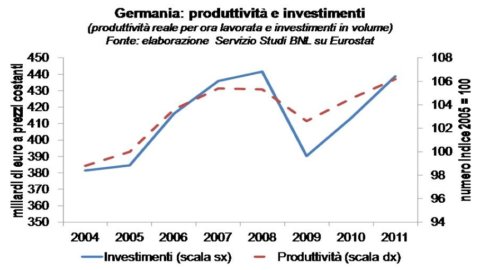Arithmetic helps to understand what exists and try to organize a future. He claimed it recently Bill Clinton in a brilliant speech largely focused on the present and future of the American economy. Two plus two equals four, not just in Arkansas. The numbers speak for themselves even if one looks at the situation of the Italian economy, which is in the midst of a complex recession.
In the second quarter of 2012, the gross domestic product of our country is seven percentage points below the value recorded in the first quarter of 2008. Conversely, the gross domestic product of Germany is now almost two points above the pre-recession levels of 2008-09. France remains behind, but only by one point. Greece, to have another point of reference, lost almost a fifth of its GDP in four years with a sixteen percent drop in employment. In Greece, between mid-2008 and mid-2012, 800 people out of a population of eleven million lost their jobs. In Italy, the decline in employed persons was of the order of XNUMX units out of XNUMX million residents. In other words, if Italy had experienced the same fall as Greece, today the job loss bill in our country would exceed four million.
Looking north of the Alps, one naturally wonders about reasons for the gap accumulated from 2008 to today by Italy compared to Germany and France. There are many, well known, explanations. Unsolved structural problems, to the detriment of the competitiveness of the country-system. Credibility gaps, which have added to our debt burden. It's all true. In addition to this, a no small reason for the 2008-2012 delta lies not in a vice, but in a virtue. The one of have more than others kept public finances under control, even in years of severe recession. Some numbers may help. Despite the contiguity of two recessions, between 2008 and 2011 the primary balance – the total balance less interest expenditure – of the Italian public accounts recorded a surplus equal to 2,7 percentage points of GDP. In this respect Italy did even better than virtuous Germany, whose cumulative primary surplus over the period stopped at two percentage points of GDP. Instead of surpluses, the public finances net of interest for France and Spain showed deficits, and not small ones.
The 2008-2012 deficit of Italian growth derives from a plus in fiscal virtue that has been imposed on us by the higher level of our public debt. Now the fiscal virtue of surplus primary balances and zero structural deficits will be demanded of everyone. The prospect of the "fiscal compact" requires it, strengthened by the judgment taken in Karlsruhe, as well as the turn made by the ECB in the direction of a new and balanced relationship between monetary support and fiscal consolidation. Other countries will have to contend with a recovery process that we have been undertaking for some time. The challenge for Italy is to maintain fiscal virtue by activating a path to recovery of growth that can no longer be postponed.
Growing in the times of the "fiscal compact" is very difficult. But without growth, the risk is also that of compromising compliance with the new parameters, starting with those on debt. The numbers say it. If public debt is equal to 120 and nominal GDP falls from 100 to 99, the ratio of public debt to gross domestic product rises to 120 ÷ 99 = 121,2 percentage points. In mid-2012, Italian GDP recorded a trend decline of 2,6 points in real terms and 1,6 points at current prices. Those 1,6 points of nominal reduction determine, ceteris paribus, almost two points of increase in the ratio between public debt and GDP. It is also this simple arithmetic that signals the urgency of a recovery. One shot based on the recovery of productivity which could be associated with a revival of productive investments. In fact, investments are the component of the product which, also in the GDP accounts for the second quarter, shows the deepest lag in Italy with respect to pre-recession data. We are talking about a real drop of twenty percentage points in four years.
The historical experience of virtuous benchmarks such as the German one indicates that there is a close correlation between structural reforms, increased investments, recovery of productivity and growth. In Germany between 2004 and 2008 the combination of the modernization of industrial relations achieved through the Hartz reforms and a strong drive for innovation in industry resulted in a seven per cent increase in real labor productivity and an increase in the fifteen per cent of business gross fixed capital formation by volume. This virtuous turning point in what was still considered the great "sick man of Europe" in the early XNUMXs allowed the German economy to face the subsequent recession much better. These are numbers and examples to be carefully considered.





